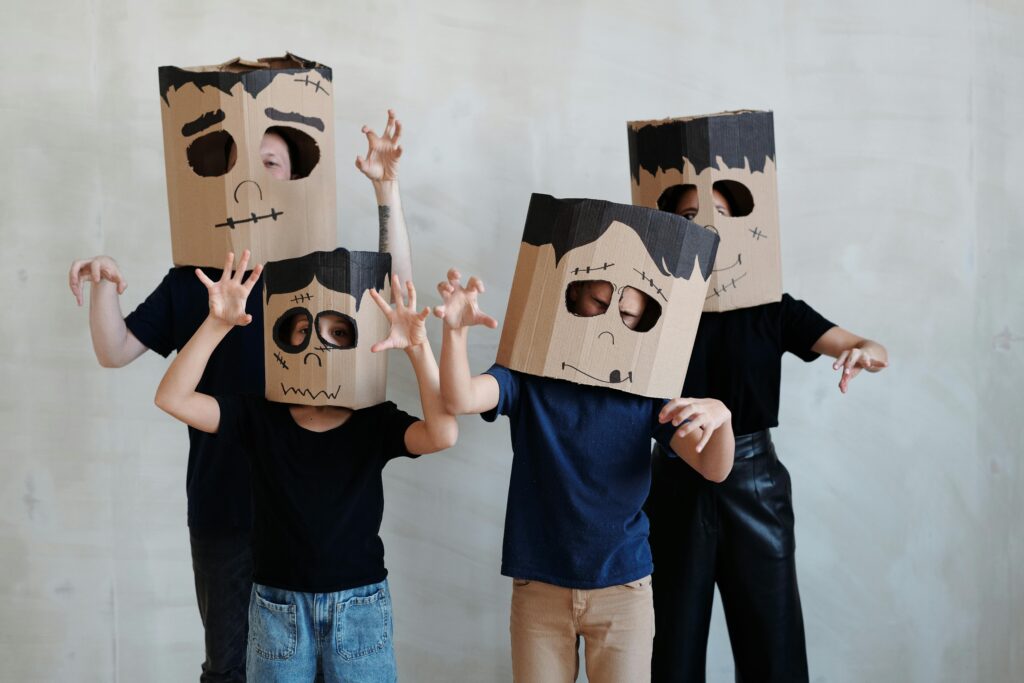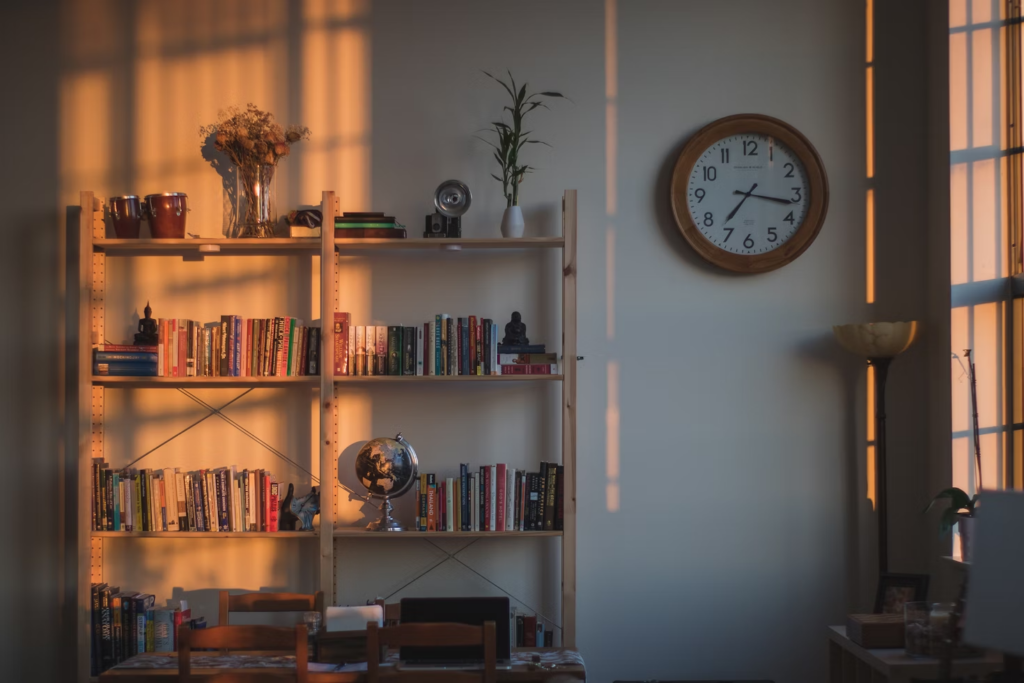"Build bonds and memories through creative DIY projects with your child, fostering communication and skills that last a lifetime."

Engaging in DIY projects with your child is an excellent opportunity to strengthen your bond and encourage open communication enjoyably and creatively. Through various DIY projects, such as science experiments, artistic pursuits, or hands-on crafting projects, your child can acquire valuable knowledge and develop practical skills. Transforming your home into a hub of DIY creativity offers a fulfilling way to make your stay-at-home moments enjoyable and memorable for the entire family.
Bookcase

If your child is a bookworm, a bookcase can be a valuable addition to your home. Not only does it provide a dedicated space for their growing collection, but it also encourages them to read more. For instance, as they finish one book, you can reward them with another, fostering a continuous love for reading. While DIY projects like building a bookcase may demand time and effort, they offer an opportunity for you and your child to bond. Engaging in such projects allows your child to become familiar with household tools, learn about construction, and develop practical skills that can be applied in various aspects of life.
Materials Needed:
- Wood boards (such as pine or plywood) for shelves and sides
- Wood screws
- Wood glue
- Wood stain or paint (optional)
- Sandpaper
- Drill
- Saw (circular saw or hand saw)
- Measuring tape
- Level
Instructions:
Step 1: Measure and cut the wood boards according to your desired bookcase dimensions. You’ll need pieces for the sides, shelves, and back panel.
Step 2: Attach the sides to the shelves using wood glue and screws to create the frame of the bookcase. Make sure everything is square and level.
Step 3: Attach the back panel to the frame using screws and wood glue. This adds stability to the bookcase.
Step 4: Sand the entire bookcase to smooth out any rough edges or surfaces. Apply wood stain or paint according to your preference. Let it dry completely.
Step 5: Use a stud finder to locate wall studs. Secure the bookcase to the wall using screws and wall anchors if necessary, especially for taller bookcases.
Step 6: Once the bookcase is securely installed, arrange your books and other items on the shelves as desired.
Terrarium

Embarking on the journey of building a terrarium with your child offers a delightful blend of creativity and education. As you construct the terrarium, you and your child can delve into the world of biology, learning about the plants you’re nurturing. Once the project is complete, it’s important to remind your child about the maintenance required to keep the plants thriving. This hands-on experience not only beautifies your living space but also provides ongoing opportunities for learning and connection with nature.
Materials Needed:
- Glass container or jar with a wide opening
- Gravel or small rocks
- Activated charcoal (optional)
- Potting soil suitable for terrariums
- Small plants (succulents, ferns, mosses, air plants)
- Decorative elements (small figurines, rocks, driftwood)
- Spray bottle filled with water
- Gloves (optional)
Instructions:
Step 1: Get a glass container that’s wide enough for easy planting. You can pick clear or coloured glass, and decide if you want it open or closed.
Step 2: Put some small rocks at the bottom for drainage. This keeps water from pooling and causing root rot. You can also add a bit of charcoal on top to keep things fresh.
Step 3: Add potting soil on top of the rocks, about 1-2 inches deep.
Step 4: Take your plants out of their pots, loosen up the roots, and plant them in the soil. Arrange them so they look nice and have space to grow.
Step 5: Spruce up your terrarium with little decorations like figurines or rocks. Just don’t go overboard and crowd the plants.
Step 6: Use a spray bottle to water the soil and plants lightly. Don’t drown them, and only water when the soil feels dry.
Step 7: Put your terrarium where it gets indirect sunlight or bright, filtered light. Avoid direct sunlight, which can fry your plants.
Step 8: Keep an eye on your terrarium for too much water, bugs, or extra growth. Trim any dead leaves and tidy up the soil. With good care, your terrarium will be a lovely addition to your home.
Birdhouse

Constructing a bird feeder or birdhouse can be a delightful project for your child, offering a charming way to entice birds into your balcony or yard while simultaneously providing them with sustenance and shelter. Encouraging your child to participate in building the feeder or house fosters their creativity and nurtures a sense of responsibility towards wildlife. As they observe the birds frequenting their creation, they can learn about different bird species and their behaviours, fostering a deeper connection to the natural world around them.
Materials Needed:
- Wood boards
- Wood screws
- Wood glue
- Drill
- Saw
- Sandpaper
- Paint or wood stain (optional)
Instructions:
Step 1: Decide on the type and size of birdhouse you want to build. You can find many free plans and designs online.
Step 2: Cut the wood boards according to the dimensions of your chosen design.
Step 3: Assemble the birdhouse using wood glue and screws. Make sure to leave an entrance hole for the birds.
Step 4: Drill drainage holes in the bottom of the birdhouse to allow water to escape and prevent the nesting area from becoming waterlogged.
Step 5: Sand the birdhouse to smooth out any rough edges. You can also paint or stain it to add colour and weather protection.
Step 6: Place the birdhouse in a suitable location, preferably mounted on a pole or hanging from a tree branch.
Step 7: Once installed, keep an eye on your birdhouse and enjoy watching the birds that come to nest in it.
Tissue Box

A handmade tissue box adds a touch of personalised charm to your home decor, showcasing your child’s artistic skills in a unique way. It can be placed in the living room, kitchen, bedrooms, or any other desired location. Your children can explore different artistic techniques and themes, allowing their creativity to shine through in every brushstroke or design choice. Remember to prioritise cleanliness as you incorporate this decorative piece into your home.
Materials Needed:
- Cardboard tissue box
- Fabric of your choice (cotton, linen, or any fabric you like)
- Scissors
- Fabric glue or sewing machine
- Decorative elements (buttons, ribbons, etc.)
Instructions:
Step 1: Lay your fabric flat and place the tissue box on top. Leave enough fabric around the box to cover it completely, with a little extra for seam allowances. Measure and cut the fabric according to the dimensions of the tissue box, adding about 1 inch (2.5 cm) to each side for seam allowances.
Step 2: Fold the fabric in half with the right sides facing inwards. If your fabric has a pattern, make sure it’s facing the inside of the fold. Sew or glue the side seams together, leaving the top and bottom open. If sewing, use a straight stitch and backstitch at the beginning and end to secure the seams.
Step 3: Test the cover on the tissue box to ensure it fits nicely. Adjust the seams if necessary.
Step 4: Hem the raw edges at the top and bottom of the cover by folding them over about 1/4 inch (0.6 cm) and sewing or glueing them down. This will give the cover a clean, finished look.
Step 5: Get creative and personalise your tissue box cover by adding decorative elements like buttons, ribbons, or appliques. Glue or sew these embellishments onto the cover as desired.
Step 6: Once your cover is complete, slide the tissue box inside and adjust the fabric as needed to ensure it sits neatly inside the cover.
Step 7: Display your cute tissue box cover in any room of your home where tissues are needed.
Custom Tote Bag

A custom tote bag DIY project is a practical endeavour for your child, offering them a versatile accessory they can carry anywhere, whether it’s to school, to the grocery store, or just hanging out with friends. It allows your child to embrace their inner artistic side, particularly if they aspire to be a designer. By customising their tote bag, they can express their creativity while also having a functional item that reflects their personality and style.
Materials Needed:
- Canvas tote bag
- Fabric paints or markers
- Paintbrushes
- Stencils (optional)
- Palette or paper plates for mixing paint
- Fabric medium (if using regular acrylic paint)
- Iron (for setting fabric paint)
Instructions:
Step 1: Lay out your canvas tote bag on a flat surface. Make sure to protect your work surface with newspaper or a drop cloth to prevent any paint spills or stains.
Step 2: Plan out your design before painting. Think about what inspires you—whether it’s art, quotes, or patterns—and lightly sketch your ideas with a pencil.
Step 3: Use fabric paints or markers to fill in your design. You can paint freely with brushes or use stencils for more precise patterns. If you’re using acrylic paint, mix it with fabric medium as per the instructions.
Step 4: Play with colours and textures to make your design pop. Painter’s tape can help create clean lines and shapes. Try different techniques to get the look you want.
Step 5: Let your tote bag dry completely to prevent smudging. This ensures the paint sticks well to the fabric.
Step 6: If you’re using fabric paint that requires heat setting, follow the instructions on the paint label. Typically, this involves ironing the painted area on the reverse side of the fabric to set the colours and make them washable.
Step 7: Once dry and set, add any final touches like your name or decorative elements such as buttons or patches. Your custom art tote bag is now ready to use!
These five recommended DIY projects offer fantastic opportunities for quality family time. Whether you engage in DIY activities with your children after their school day or during weekend downtime, they are sure to infuse an element of fun into your family’s time at home. Consider extending your DIY adventures into the kitchen with your kids, teaching them basic cooking skills that will prove invaluable as they grow older. Read Smart Food Choices for Kids’ During Exams. While some DIY projects may require time and patience, they are ultimately rewarding activities that strengthen bonds and create lasting memories for the entire family.
